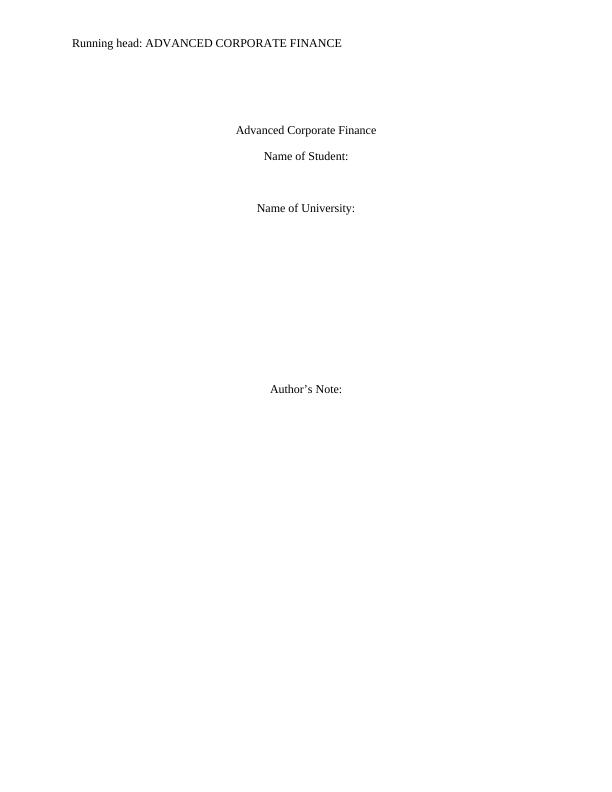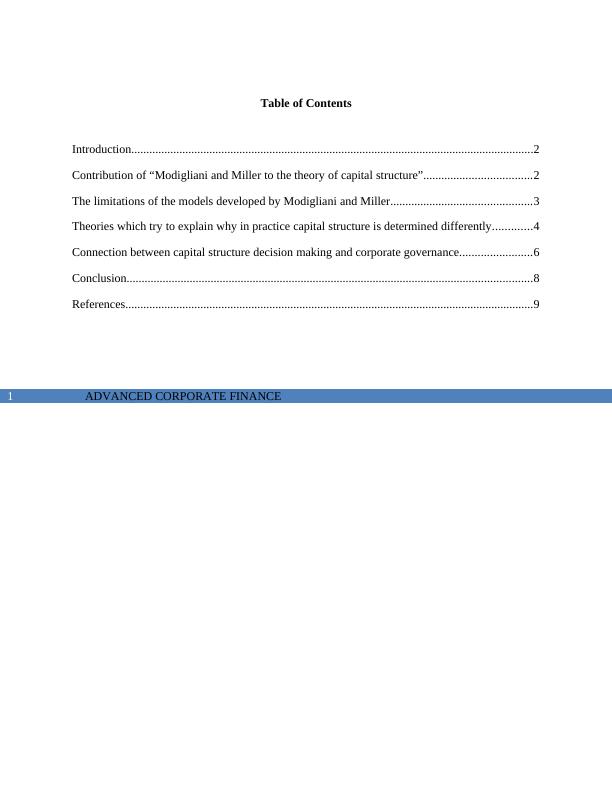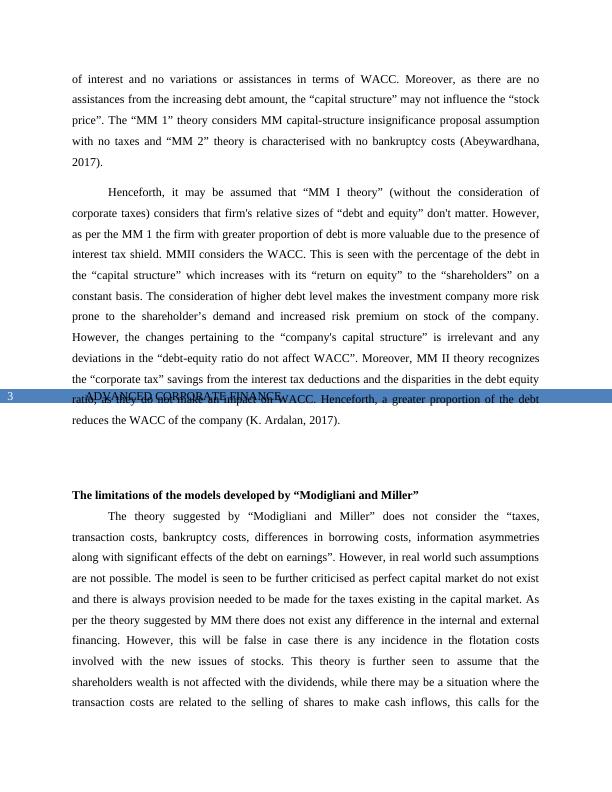Assignment on Advanced Corporate Finance
Added on 2020-05-16
12 Pages3820 Words192 Views
Running head: ADVANCED CORPORATE FINANCEAdvanced Corporate FinanceName of Student:Name of University:Author’s Note:

ADVANCED CORPORATE FINANCE1Table of ContentsIntroduction......................................................................................................................................2Contribution of “Modigliani and Miller to the theory of capital structure”....................................2The limitations of the models developed by Modigliani and Miller...............................................3Theories which try to explain why in practice capital structure is determined differently.............4Connection between capital structure decision making and corporate governance........................6Conclusion.......................................................................................................................................8References........................................................................................................................................9

ADVANCED CORPORATE FINANCE2IntroductionThe “capital structure” of a company is considered as the means by which anorganization can finance its assets. A “company” is able to “finance its processes either withequity or debt or with combination of both. The “capital structure” may compose of majority ofthe “debt or majority of equity or mixture of both”. In the 1950s two instructors “Modigliani andMiller”, analysed a “capital-structure theory” profoundly. The theory advocates capital structureirrelevancy which suggest that a firm which is “highly leveraged” or bears “lower debt”constituent has no impact on the “market value”. It also advocates that the firm valuation has norelevance with the “capital structure of the company”. The main rationale of the value of marketof the firm is discerned to be reliant on the operating profits. The learnings of the study aim toshow the contribution of “Modigliani and Miller” to the theory of “capital structure”. Thelearnings of the study have also suggested it’s limitations and theories which try to explain whyin practice capital structure is determined differently and draw a Connection between capitalstructure decision making and corporate governance (Ahmeti & Prenaj, 2015).Contribution of “Modigliani and Miller to the theory of capital structure”The main aspects of the analysis developed by “Modigliani and Miller” conjectured thatthe determination of “market value” is done by the earning power and “risk of underlying assets”along with the self-determining way it indicates to finance the investment and “distributedividends”. The key assumptions of M&M proposition are considered with factors such as “Notaxes, No transaction costs, No bankruptcy costs, Equivalence in borrowing costs for bothcompanies and investors”. Along with the information, it also considers “symmetry of marketinformation, investors who have the same information, and there is no effect of debt on acompany's earnings before interest and taxes” (Kennedy et al., 2015).“Modigliani and Miller's Capital-Structure Irrelevance Proposition”The assumptions of the “M&M capital structure” show that there is irrelevanceproposition and assumption of no taxes or bankruptcy costs. In simplified terms it shows that theWACC will continue to be persistent with the changes pertaining to “capital structure” of thecompany. No matter, the way firm borrow, there won’t be any “tax benefit” because of payment

ADVANCED CORPORATE FINANCE3of interest and no variations or assistances in terms of WACC. Moreover, as there are noassistances from the increasing debt amount, the “capital structure” may not influence the “stockprice”. The “MM 1” theory considers MM capital-structure insignificance proposal assumptionwith no taxes and “MM 2” theory is characterised with no bankruptcy costs (Abeywardhana,2017).Henceforth, it may be assumed that “MM I theory” (without the consideration ofcorporate taxes) considers that firm's relative sizes of “debt and equity” don't matter. However,as per the MM 1 the firm with greater proportion of debt is more valuable due to the presence ofinterest tax shield. MMII considers the WACC. This is seen with the percentage of the debt inthe “capital structure” which increases with its “return on equity” to the “shareholders” on aconstant basis. The consideration of higher debt level makes the investment company more riskprone to the shareholder’s demand and increased risk premium on stock of the company.However, the changes pertaining to the “company's capital structure” is irrelevant and anydeviations in the “debt-equity ratio do not affect WACC”. Moreover, MM II theory recognizesthe “corporate tax” savings from the interest tax deductions and the disparities in the debt equityratio, as they do not make an impact on WACC. Henceforth, a greater proportion of the debtreduces the WACC of the company (K. Ardalan, 2017).The limitations of the models developed by “Modigliani and Miller”The theory suggested by “Modigliani and Miller” does not consider the “taxes,transaction costs, bankruptcy costs, differences in borrowing costs, information asymmetriesalong with significant effects of the debt on earnings”. However, in real world such assumptionsare not possible. The model is seen to be further criticised as perfect capital market do not existand there is always provision needed to be made for the taxes existing in the capital market. Asper the theory suggested by MM there does not exist any difference in the internal and externalfinancing. However, this will be false in case there is any incidence in the flotation costsinvolved with the new issues of stocks. This theory is further seen to assume that theshareholders wealth is not affected with the dividends, while there may be a situation where thetransaction costs are related to the selling of shares to make cash inflows, this calls for the

End of preview
Want to access all the pages? Upload your documents or become a member.
Related Documents
Financial Decision Making Solution Assignment (Doc)lg...
|15
|1919
|165
Dividend Irrelevance and Capital Structure Theorieslg...
|7
|2067
|323
Modigliani and Miller's Theorem of Capital Structure in Corporate Financelg...
|4
|647
|72
Fundamentals of Corporate Finance Assignmentlg...
|5
|757
|22
Financelg...
|5
|746
|152
Capital Structure: Theories and Analysis of Sainsbury and Tesco Plc.lg...
|12
|2254
|381